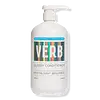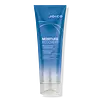What's inside
What's inside
 Key Ingredients
Key Ingredients

No key ingredients
 Benefits
Benefits

 Concerns
Concerns

 Ingredients Side-by-side
Ingredients Side-by-side

Water
Skin ConditioningGlycerin
HumectantButyrospermum Parkii Butter
Skin ConditioningDimethicone
EmollientStearyl Alcohol
EmollientCetyl Alcohol
EmollientBehentrimonium Chloride
PreservativeSorbitol
HumectantStearamidopropyl Dimethylamine
EmulsifyingAmodimethicone
Hydrogenated Castor Oil/Sebacic Acid Copolymer
EmollientHydrogenated Palm Oil
EmollientHydrogenated Hemp Seed Oil
EmollientPEG-7 Glyceryl Cocoate
EmulsifyingPhenyl Trimethicone
Skin ConditioningPrunus Persica Kernel Oil
EmollientRosa Canina Fruit Oil
EmollientHydrolyzed Vegetable Protein Pg-Propyl Silanetriol
Skin ConditioningCaprylyl 2-Glyceryl Ascorbate
AntioxidantCystine Bis-Pg-Propyl Silanetriol
Skin ConditioningParfum
MaskingSqualane
EmollientQuaternium-80
Cetrimonium Chloride
AntimicrobialIsopropyl Alcohol
SolventCitric Acid
BufferingTrideceth-12
EmulsifyingHydroxyethylcellulose
Emulsion StabilisingCaprylyl Glycol
EmollientPolyquaternium-10
Chlorphenesin
AntimicrobialPolyquaternium-67
Mannitol
HumectantXylitylglucoside
HumectantAnhydroxylitol
HumectantMyristyl Alcohol
EmollientPropylene Glycol
HumectantXylitol
HumectantSodium Acetate
BufferingDisodium EDTA
Potassium Sorbate
PreservativeSodium Chloride
MaskingCellulose
AbsorbentLactic Acid
BufferingEthylhexylglycerin
Skin ConditioningPhenoxyethanol
PreservativeButylphenyl Methylpropional
PerfumingHydroxycitronellal
PerfumingLimonene
PerfumingLinalool
PerfumingWater, Glycerin, Butyrospermum Parkii Butter, Dimethicone, Stearyl Alcohol, Cetyl Alcohol, Behentrimonium Chloride, Sorbitol, Stearamidopropyl Dimethylamine, Amodimethicone, Hydrogenated Castor Oil/Sebacic Acid Copolymer, Hydrogenated Palm Oil, Hydrogenated Hemp Seed Oil, PEG-7 Glyceryl Cocoate, Phenyl Trimethicone, Prunus Persica Kernel Oil, Rosa Canina Fruit Oil, Hydrolyzed Vegetable Protein Pg-Propyl Silanetriol, Caprylyl 2-Glyceryl Ascorbate, Cystine Bis-Pg-Propyl Silanetriol, Parfum, Squalane, Quaternium-80, Cetrimonium Chloride, Isopropyl Alcohol, Citric Acid, Trideceth-12, Hydroxyethylcellulose, Caprylyl Glycol, Polyquaternium-10, Chlorphenesin, Polyquaternium-67, Mannitol, Xylitylglucoside, Anhydroxylitol, Myristyl Alcohol, Propylene Glycol, Xylitol, Sodium Acetate, Disodium EDTA, Potassium Sorbate, Sodium Chloride, Cellulose, Lactic Acid, Ethylhexylglycerin, Phenoxyethanol, Butylphenyl Methylpropional, Hydroxycitronellal, Limonene, Linalool
Water
Skin ConditioningCetearyl Alcohol
EmollientDimethicone
EmollientSorbitol
HumectantPropylene Glycol
HumectantBehentrimonium Chloride
PreservativeStearyl Alcohol
EmollientPhenoxyethanol
PreservativeCocos Nucifera Oil
MaskingRosa Canina Fruit Oil
EmollientLaurdimonium Hydroxypropyl Hydrolyzed Keratin
Skin ConditioningSimmondsia Chinensis Seed Oil
EmollientChlorella Vulgaris Extract
Skin ConditioningSea Water
HumectantHydrolyzed Algin
Arginine Hcl
Skin ConditioningPhosphatidylcholine
EmulsifyingIsopropyl Palmitate
EmollientCetyl Esters
EmollientHydroxyethylcellulose
Emulsion StabilisingCetrimonium Chloride
AntimicrobialGuar Hydroxypropyltrimonium Chloride
Skin ConditioningPolyquaternium-37
Aminopropyl Dimethicone
Tetrasodium Glutamate Diacetate
Propylene Glycol Dicaprylate/Dicaprate
EmollientPEG-4 Laurate
EmulsifyingCitric Acid
BufferingPEG-90m
Emulsion StabilisingPPG-1 Trideceth-6
Skin ConditioningIodopropynyl Butylcarbamate
PreservativeSodium Hydroxide
BufferingIsopropyl Alcohol
SolventLimonene
PerfumingBenzyl Benzoate
AntimicrobialParfum
MaskingCI 60730
Cosmetic ColorantCI 42090
Cosmetic ColorantCI 19140
Cosmetic ColorantWater, Cetearyl Alcohol, Dimethicone, Sorbitol, Propylene Glycol, Behentrimonium Chloride, Stearyl Alcohol, Phenoxyethanol, Cocos Nucifera Oil, Rosa Canina Fruit Oil, Laurdimonium Hydroxypropyl Hydrolyzed Keratin, Simmondsia Chinensis Seed Oil, Chlorella Vulgaris Extract, Sea Water, Hydrolyzed Algin, Arginine Hcl, Phosphatidylcholine, Isopropyl Palmitate, Cetyl Esters, Hydroxyethylcellulose, Cetrimonium Chloride, Guar Hydroxypropyltrimonium Chloride, Polyquaternium-37, Aminopropyl Dimethicone, Tetrasodium Glutamate Diacetate, Propylene Glycol Dicaprylate/Dicaprate, PEG-4 Laurate, Citric Acid, PEG-90m, PPG-1 Trideceth-6, Iodopropynyl Butylcarbamate, Sodium Hydroxide, Isopropyl Alcohol, Limonene, Benzyl Benzoate, Parfum, CI 60730, CI 42090, CI 19140
Ingredients Explained
These ingredients are found in both products.
Ingredients higher up in an ingredient list are typically present in a larger amount.
This ingredient is a preservative and often used for it's anti-static properties. You'll most likely see this ingredient in hair conditioners.
It does not cause irritation or sensitization in leave-on products at 1-5%.
This ingredient is a preservative, antimicrobial, and emulsifier. It is often used in cosmetics for its ability to cleanse, condition, and reduce static.
Cetrimonium chloride is a quaternary ammonium salt, meaning it has a water-soluble structure.
Citric Acid is an alpha hydroxy acid (AHA) naturally found in citrus fruits like oranges, lemons, and limes.
Like other AHAs, citric acid can exfoliate skin by breaking down the bonds that hold dead skin cells together. This helps reveal smoother and brighter skin underneath.
However, this exfoliating effect only happens at high concentrations (20%) which can be hard to find in cosmetic products.
Due to this, citric acid is usually included in small amounts as a pH adjuster. This helps keep products slightly more acidic and compatible with skin's natural pH.
In skincare formulas, citric acid can:
While it can provide some skin benefits, research shows lactic acid and glycolic acid are generally more effective and less irritating exfoliants.
Most citric acid used in skincare today is made by fermenting sugars (usually from molasses). This synthetic version is identical to the natural citrus form but easier to stabilize and use in formulations.
Read more about some other popular AHA's here:
Learn more about Citric AcidDimethicone is a type of synthetic silicone created from natural materials such as quartz.
What it does:
Dimethicone comes in different viscosities:
Depending on the viscosity, dimethicone has different properties.
Ingredients lists don't always show which type is used, so we recommend reaching out to the brand if you have questions about the viscosity.
This ingredient is unlikely to cause irritation because it does not get absorbed into skin. However, people with silicone allergies should be careful about using this ingredient.
Note: Dimethicone may contribute to pilling. This is because it is not oil or water soluble, so pilling may occur when layered with products. When mixed with heavy oils in a formula, the outcome is also quite greasy.
Learn more about DimethiconeHydroxyethylcellulose is used to improve the texture of products. It is created from a chemical reaction involving ethylene oxide and alkali-cellulose. Cellulose is a sugar found in plant cell walls and help give plants structure.
This ingredient helps stabilize products by preventing ingredients from separating. It can also help thicken the texture of a product.
This ingredient can also be found in pill medicines to help our bodies digest other ingredients.
Learn more about HydroxyethylcelluloseIsopropyl Alcohol is more commonly known as rubbing alcohol. It is most commonly used as a solvent, meaning it helps other ingredients dissolve.
This ingredient is an astringent alcohol. Astringent alcohols may also irritate skin as they high amounts may strip away your skin's natural oils.
Other types of astringent alcohols include:
According to the National Rosacea Society based in the US, you should be mindful of products with these alcohols in the top half of ingredients.
Any type of sanitizing product will have high amounts of alcohol to help kill bacteria and viruses.
Learn more about Isopropyl AlcoholLimonene is a fragrance that adds scent and taste to a formulation.
It's found in the peel oil of citrus fruits and other plants such as lavender and eucalyptus. The scent of limonene is generally described as "sweet citrus".
Limonene acts as an antioxidant, meaning it helps neutralize free radicals.
When exposed to air, oxidized limonene may sensitize the skin. Because of this, limonene is often avoided by people with sensitive skin.
The term 'fragrance' is not regulated in many countries. In many cases, it is up to the brand to define this term. For instance, many brands choose to label themselves as "fragrance-free" because they are not using synthetic fragrances. However, their products may still contain ingredients such as essential oils that are considered a fragrance.
Learn more about LimoneneParfum is a catch-all term for an ingredient or more that is used to give a scent to products.
Also called "fragrance", this ingredient can be a blend of hundreds of chemicals or plant oils. This means every product with "fragrance" or "parfum" in the ingredients list is a different mixture.
For instance, Habanolide is a proprietary trade name for a specific aroma chemical. When used as a fragrance ingredient in cosmetics, most aroma chemicals fall under the broad labeling category of “FRAGRANCE” or “PARFUM” according to EU and US regulations.
The term 'parfum' or 'fragrance' is not regulated in many countries. In many cases, it is up to the brand to define this term.
For instance, many brands choose to label themselves as "fragrance-free" because they are not using synthetic fragrances. However, their products may still contain ingredients such as essential oils that are considered a fragrance by INCI standards.
One example is Calendula flower extract. Calendula is an essential oil that still imparts a scent or 'fragrance'.
Depending on the blend, the ingredients in the mixture can cause allergies and sensitivities on the skin. Some ingredients that are known EU allergens include linalool and citronellol.
Parfum can also be used to mask or cover an unpleasant scent.
The bottom line is: not all fragrances/parfum/ingredients are created equally. If you are worried about fragrances, we recommend taking a closer look at an ingredient. And of course, we always recommend speaking with a professional.
Learn more about ParfumPhenoxyethanol is a preservative that has germicide, antimicrobial, and aromatic properties. Studies show that phenoxyethanol can prevent microbial growth. By itself, it has a scent that is similar to that of a rose.
It's often used in formulations along with Caprylyl Glycol to preserve the shelf life of products.
Propylene Glycol is an odorless, colorless liquid. As a humectant, it helps skin retain moisture. It also aids in delivering active ingredients.
Another role of this ingredient is preventing a product from melting or freezing. Propylene glycol also adds antimicrobrial properties to a product, elongating product lifespan.
This ingredient is considered an organic alcohol and commonly added into both cosmetics and foods.
Those with sensitive skin or conditions may develop a rash when using this ingredient.
Learn more about Propylene GlycolRosehip Oil is a non-fragrant plant oil. Rosehips are a fruit from a rose bush and are edible. This oil has skin conditioning and hydrating properties.
Rosehip contains Vitamin C, Vitamin E, fatty acids and linolenic acids. These nourish your skin barrier. Having hydrated skin may help reduce the appearance of fine-lines and wrinkles.
Another great component of Rosehip Oil is Vitamin A, or retinol. Vitamin A encourages your skin to create more collagen.
Rosehip oil may help with reducing pigmentation. The lycopene and beta-carotene have skin-lightening properties. However, more studies are needed to confirm this.
Learn more about Rosa Canina Fruit OilSorbitol is a sugar alcohol. It is a hydrating and moisturizing agent created from the reduction process of glucose.
Most sorbitol is usually made from potato starch. It is also found in fruits such as apples and pears.
As a humectant, Sorbitol helps draw water to the skin. This helps keep the skin hydrated. Sorbitol also helps create a thicker texture in products. You might find sorbitol in your toothpaste and other gels.
It is a non-irritating ingredient that is great for those with dry skin.
Sorbitol is a prebiotic. It helps promote the growth of healthy bacteria on your skin. The bacteria on your skin form a microbiome. This microbiome helps protect your skin from infection and harmful bacteria.
Learn more about SorbitolStearyl Alcohol is a type of fatty alcohol from stearic acid. It is a white, waxy compound used to emulsify ingredients.
Fatty Alcohols are most often used as an emollient or to thicken a product. Emollients help soothe and hydrate the skin by trapping moisture.
They are usually derived from natural fats and oils and therefore do not have the same drying or irritating effect as solvent alcohols. FDA allows products labeled "alcohol-free" to have fatty alcohols.
Learn more about Stearyl AlcoholWater. It's the most common cosmetic ingredient of all. You'll usually see it at the top of ingredient lists, meaning that it makes up the largest part of the product.
So why is it so popular? Water most often acts as a solvent - this means that it helps dissolve other ingredients into the formulation.
You'll also recognize water as that liquid we all need to stay alive. If you see this, drink a glass of water. Stay hydrated!
Learn more about Water